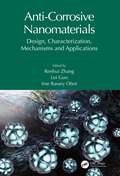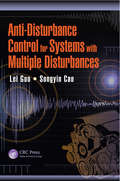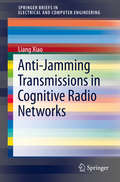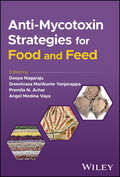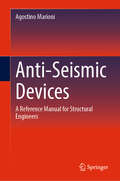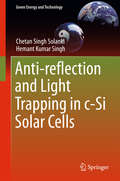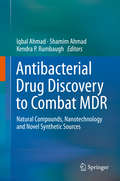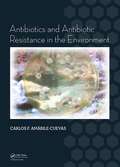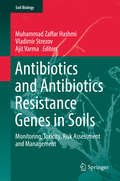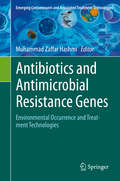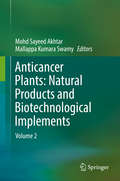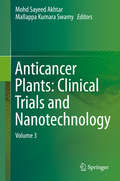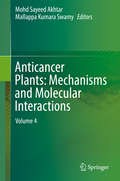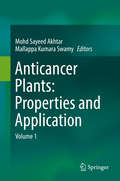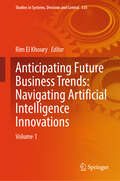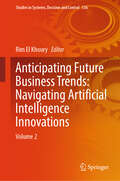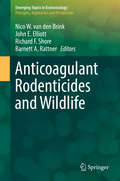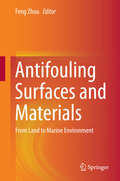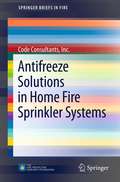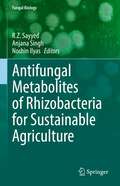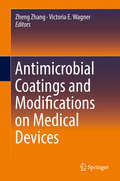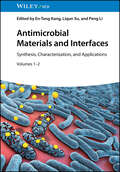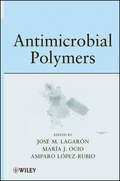- Table View
- List View
Anti-Angiogenic Functional and Medicinal Foods
by Fereidoon Shahidi Debasis Bagchi Jack N. LossoThe ability to regulate and manipulate the generation or remodeling of blood vessels is key to the successful treatment of many chronic diseases, both oncological and non-oncological. Several bioactive compounds present in human diets are now known to exert an inhibitive effect on the either the signaling or construction of new blood vessels. The i
Anti-Corrosive Nanomaterials: Design, Characterization, Mechanisms and Applications
by Lei Guo Renhui Zhang Ime Bassey ObotCorrosion is a great challenge in many industries, especially in the automotive, aerospace, and oil and gas industries, with conservative estimations accounting for losses of around 2.2 trillion US dollars per year in the United States alone. Providing a comprehensive overview of the history and development of nanomaterials, this book discusses various practices for protection against corrosion. Key Features: Provides a comprehensive and updated review of major innovations in the field of nanomaterials in industrial, corrosion, and environmental science and engineering Encompasses design, characterization, mechanism, and application of nanomaterials from different strategies on the efficacy and major challenges associated with successful scaleup designing Essential reference for present and future research in nanomaterials Includes relevant aspects of organic and inorganic nanomaterials, hybrid nanomaterials, and nanocoatings in anticorrosion applications Coalescing a wide range of research on nanomaterials and anticorrosion practices, this book is of particular appeal to students, industry professionals, and academics.
Anti-Disturbance Control for Systems with Multiple Disturbances (Automation and Control Engineering)
by Lei Guo Songyin CaoThe main focus of this monograph will be on the Enhanced Anti-Disturbance Control and filtering theory and their applications. In fact, the classical anti-disturbance control theory only considered one "equivalent" disturbance which is merged by different unknown sources. However, it is noted that along with the development of information obtaining and processing technologies, one can get more information or knowledge about various types of disturbances.
Anti-Jamming Transmissions in Cognitive Radio Networks (SpringerBriefs in Electrical and Computer Engineering #0)
by Liang XiaoThis SpringerBrief examines anti-jamming transmissions in cognitive radio networks (CRNs), including several recent related research topics within this field. The author introduces the transmissions based on uncoordinated spread spectrum to address smart jammers in CRNs. The author applies game theory to investigate the interactions between secondary users and jammers while providing game theoretic solutions to suppress jamming incentives in CRNs. Later chapters evaluate the Nash equilibrium and Stackelberg equilibrium of the jamming games under various network scenarios. Professionals and researchers working in networks, wireless communications and information technology will find Anti-Jamming Transmissions in Cognitive Radio Networks valuable material as a reference. Advanced-level students studying electrical engineering and computer science will also find this brief a useful tool.
Anti-Mycotoxin Strategies for Food and Feed
by Deepa Nagaraju Sreenivasa Marikunte Yanjarappa Premila N. Achar Angel Medina VayaAnti-Mycotoxin Strategies for Food and Feed Up-to-date information on mycotoxigenic fungi and toxins, with methods to control them in food and feed Anti-Mycotoxin Strategies for Food and Feed focuses on strategies to control the health risk of mycotoxins associated with cereals, pulses, and vegetables during post and pre harvest stages, in addition to foods, food-based products, and feeds. Each chapter is carefully designed to offer information elucidating various strategies, which include physical, chemical, and biological methods. The book provides a combined approach of advanced techniques used against mycotoxigenic fungi, which is helpful in studying the strategies for different mycotoxins. Special attention has been paid to diseases caused by mycotoxigenic fungi and their destructive effect on either preharvest, post-harvest, or storage, and their respective toxins which pose a long-term health risk to humans and animals, if contaminated food or feed enter our food chain. The primary focus of the text is on the recent and advanced approaches and strategies including control, detoxification, degradation and binding methods, with graphical representations of protocols with supporting tables and figures. Anti-Mycotoxin Strategies discusses specific sample topics such as: Advanced anti-fumonisin strategies and strategies for the control of aflatoxigenic Aspergillus species in contaminated food and feed Innovative strategies to decontaminate Ochratoxin A and Zearalenone. Effects of toxic citrinin, patulin and Ergot alkaloids in animals, birds, and humans, and effective mitigation strategies as its control measures. Detoxification and Decontamination strategies of Deoxynivalenol an emetic toxin, Trichothecenes, T-2/HT-2 toxin and nivalenol associated in food and feed as contaminants. Presenting and discussing mycotoxin management strategies at length and enabling readers to reduce or eliminate health hazards to humans and animals, Anti-Mycotoxin Strategies is an essential resource for mycologists, mycotoxicologists, Microbiologists, Food technology professionals in the food, seed, and feed industries, scientists, students, researchers, and farmers / agriculturists.
Anti-Seismic Devices: A Reference Manual for Structural Engineers
by Agostino MarioniThis book stands as a manual and ready reference for structural engineers on the seismic protection of civil engineering structures. Beginning with a short historical overview, the book explains the concepts of seismic protection, describes the most common types of anti-seismic devices, and summarizes the main existing standards for anti-seismic devices, with particular reference to the European Standard. It imparts expertise on the devices that is normally restricted by proprietary interests of a few specialists. Then it goes on to illustrate the main differences between European and American Standards, examine the output of the principle laboratories globally engaged in testing anti-seismic devices, and to describe state-of-art technologies to retrofit seismically existing buildings. The volume concludes with a number of accounts of projects involving the author where structures were equipped with anti-seismic devices and provides some insight on the future development of relevant technologies.
Anti-reflection and Light Trapping in c-Si Solar Cells (Green Energy and Technology)
by Hemant Kumar Singh Chetan Singh SolankiThis book offers essential insights into c-Si based solar cells and fundamentals of reflection, refraction, and light trapping. The basic physics and technology for light trapping in c-Si based solar cells are covered, from traditional to advanced light trapping structures. Further, the book discusses the latest developments in plasmonics for c-Si solar cell applications, along with their future scope and the requirements for further research. The book offers a valuable guide for graduate students, researchers and professionals interested in the latest trends in solar cell technologies.
Antibacterial Drug Discovery to Combat MDR: Natural Compounds, Nanotechnology and Novel Synthetic Sources
by Iqbal Ahmad Kendra P. Rumbaugh Shamim AhmadThis book compiles the latest information in the field of antibacterial discovery, especially with regard to the looming threat of multi-drug resistance. The respective chapters highlight the discovery of new antibacterial and anti-infective compounds derived from microbes, plants, and other natural sources. The potential applications of nanotechnology to the fields of antibacterial discovery and drug delivery are also discussed, and one section of the book is dedicated to the use of computational tools and metagenomics in antibiotic drug discovery. Techniques for efficient drug delivery are also covered. The book provides a comprehensive overview of the progress made in both antibacterial discovery and delivery, making it a valuable resource for academic researchers, as well as those working in the pharmaceutical industry.
Antibiotics and Antibiotic Resistance in the Environment
by Carlos F. Amabile-CuevasThe presence of antibiotics, antibiotic resistance genes, and antibiotic resistant bacteria in the environment is a cause of growing worldwide concern, as it reveals the extensive impact of antibiotic abuse and other human-related pressures upon microbes. The field of detecting and measuring resistance in the environment has rapidly evolved to a systematic search of organisms and genes. This book will review the available evidence and hypotheses on where antibiotic resistance is coming from and for how long it has been there. Further, it will discuss involved maintenance pressures, resistance spread, traits and laboratory and in-silico strategies to further investigate antibiotic resistance.
Antibiotics and Antibiotics Resistance Genes in Soils: Monitoring, Toxicity, Risk Assessment And Management (Soil Biology Ser. #51)
by Ajit Varma Muhammad Zaffar Hashmi Vladimir StrezovThis book summarizes the current state of knowledge regarding antibiotics and antibiotics resistance genes (ARGs) in the soil environment. It covers a wide range of topics to help readers understand antibiotics and ARGs in soils, the risks they pose for the environment, and options for effective control. In addition, it presents a range of essential tools and methodologies that can be used to address antibiotics and ARGs in a consistent, efficient, and cost-effective manner. Gathering contributions by international experts, the book addresses both theoretical aspects and practical applications. The topics discussed include antibiotics-producing microorganisms; the routes of entry and fate of antibiotics and resistance genes; biomonitoring approaches; dissemination of ARGs in soils; risk assessment; the impact of antibiotics and ARGs on the soil microbial community and other biota; bioremediation and biodegradation approaches; and soil management strategies for antibiotics and ARG-contaminated soils. As such, the book will be of interest to students, researchers and scholars in environmental science and engineering, toxicology, the medical and pharmaceutical sciences, environmental biotechnology, soil sciences, microbial ecology and plant biotechnology. Readers and Journals: 1. This new volume on antibiotics and antibiotics resistance genes (ARGs) in the soil environment will be of interest to students, researchers and scholars in environmental science and engineering, toxicology, the medical and pharmaceutical sciences, environmental biotechnology, soil sciences,microbial ecology and plant biotechnology. 2. The book will provide government authorities all over the world with effective strategies for the management of antibiotics and antibiotics resistance genes (ARG)- contaminated soil. 3. Gathering contributions by international experts,the book addresses both theoretical aspects and practical applications.
Antibiotics and Antimicrobial Resistance Genes: Environmental Occurrence and Treatment Technologies (Emerging Contaminants and Associated Treatment Technologies)
by Muhammad Zaffar HashmiThis volume summarizes and updates information about antibiotics and antimicrobial resistance (AMR)/antibiotic resistant genes (ARG) production, including their entry routes in soil, air, water and sediment, their use in hospital and associated waste, global and temporal trends in use and spread of antibiotics, AMR and ARG. Antimicrobial/antibiotic resistance genes due to manure and agricultural waste applications, bioavailability, biomonitoring, and their Epidemiological, ecological and public health effects. The book addresses the antibiotic and AMR/ARG risk assessment and treatment technologies, for managing antibiotics and AMR/ARG impacted environments The book's expert contributions span 20 chapters, and offer a comprehensive framework for better understanding and analyzing the environmental and social impacts of antibiotics and AMR/ARGs. Readers will have access to recent and updated models regarding the interpretation of antibiotics and AMR/ARGs in environment and biomonitoring studies, and will learn about the management options require to appropriately mitigate environmental contaminants and pollution. The book will be of interest to students, teachers, researchers, policy makers and environmental organizations.
Anticancer Plants: Volume 2
by Mohd Sayeed Akhtar Mallappa Kumara SwamyThis volume provides summarized scientific evidence of the different classes of plant-derived phytocompounds, their sources, chemical structures, anticancer properties, mechanisms of action, methods of extraction, and their applications in cancer therapy. It also discusses endophyte-derived compounds as chemopreventives to treat various cancer types. In addition, it provides detailed information on the enhanced production of therapeutically valuable anticancer metabolites using biotechnological interventions such as plant cell and tissue culture approaches, including in vitro-, hairy root- and cell-suspension culture; and metabolic engineering of biosynthetic pathways. Anticancer Plants: Natural Products and Biotechnological Implements – Volume 2” explores the natural bioactive compounds isolated from plants as well as fungal endophytes, their chemistry, and preventive effects to reduce the risk of cancer. Moreover, it highlights the genomics/proteomics approaches and biotechnological implementations. Providing solutions to deal with the challenges involved in cancer therapy, the book benefits a wide range of readers including academics, students, and industrial experts working in the area of natural products, medicinal plant chemistry, pharmacology, and biotechnology.
Anticancer Plants: Volume 3
by Mohd Sayeed Akhtar Mallappa Kumara SwamyCancer is one of the leading causes of death in human beings. Though several synthetic medicines are used to treat cancer, they are largely inefficient and unsafe. In contrast, plants, which have been used for medicinal purposes since time immemorial, have proved to be useful in fighting cancer, with natural compounds from plants and their derivatives offering safe and effective treatment and management for several types of cancer.Plants such as Catharanthus roseus, Podophyllum peltatum, Taxus brevifolia, Camptotheca acuminate, Andrographis paniculata, Crateva nurvala, Croton tonkinensis, Oplopanax horridus etc., are important source of chemotherapeutic compounds. These plants have proven their value in the treatment of cancer and various other infectious diseases, and several common anticancer compounds such as taxol, podophyllotoxins, camptothecin, vinblastine, vincristine, homoharringtonine etc. have been isolated and purified from these medicinal plants.Unfortunately, many of these anticancer plants have become endangered due to ruthless and irresponsible harvesting practices. Hence, there is a need to conserve these species and to propagate them on a large scale using plant tissue culture. Alternatively, plant cell tissue and organ culture biotechnology could be adopted to produce these anticancer compounds without the need for cultivation. A better grasp and continuing exploration of these isolated molecules and products could provide a powerful alternative means of reducing cancer risk.“Anticancer Plants: Volume 3, Clinical Trials and Nanotechnology” provides a timely review of concepts and experimental data on the application of anticancer plants and their compounds in clinical trials, and on the use of nanotechnology in cancer therapy.
Anticancer Plants: Volume 4
by Mohd Sayeed Akhtar Mallappa Kumara SwamyThis book summarizes the application of plant derived anticancer compounds as chemopreventives to treat several cancer types, focusing on the molecular mechanisms of action of phytocompounds and providing an overview of the basic processes at the cellular and molecular level that are involved in the progression of the cancer and can be employed in targeted preventive therapies. In addition, it highlights the development of novel anticancer drugs from plant sources using bioinformatics approaches. The compiled chapter data aids readers understanding of issues related to bioavailability, toxic effects and mechanisms of action of phytocompounds, and helps them identify the leads and utilize them against various cancer types effectively. Furthermore, it promotes the use of bioinformatics tools in medicinal plants to expedite their use in plant breeding programs to develop molecular markers to distinguish disease subtypes and predicting mutation, which in turn improves cancer diagnosis and prognosis, and to develop new lead compounds computationally. The book provides scientific verifications of plant compounds mechanisms of action against various cancers and offers useful information for students, teachers, and healthcare professionals involved in drug discovery, and clinical and therapeutic research.
Anticancer plants: Volume 1
by Mohd Sayeed Akhtar Mallappa Kumara SwamyCancer is one of the leading death cause of human population increasingly seen in recent times. Plants have been used for medicinal purposes since immemorial times. Though, several synthetic medicines are useful in treating cancer, they are inefficient and unsafe. However, plants have proved to be useful in cancer cure. Moreover, natural compounds from plants and their derivatives are safe and effective in treatment and management of several cancer types.The anticancer plants such as Catharanthus roseus, Podophyllum peltatum, Taxus brevifolia, Camptotheca acuminate, Andrographis paniculata, Crateva nurvala, Croton tonkinensis, Oplopanax horridus etc., are important source of chemotherapeutic compounds. These plants have proven their significance in the treatment of cancer and various other infectious diseases. Nowadays, several well-known anticancer compounds such as taxol, podophyllotoxins, camptothecin, vinblastine, vincristine, homoharringtonine etc. have been isolated and purified from these medicinal plants. Many of them are used effectively to combat cancer and other related diseases. The herbal medicine and their products are the most suitable and safe to be used as an alternative medicine. Based on their traditional uses and experimental evidences, the anticancer products or compounds are isolated or extracted from the medicinally important plants. Many of these anticancer plants have become endangered due to ruthless harvesting in nature. Hence, there is a need to conserve these species and to propagate them in large scale using plant tissue culture. Alternatively, plant cell tissue and organ culture biotechnology can be adopted to produce these anticancer compounds without cultivation. The proper knowledge and exploration of these isolated molecules or products could provide an alternative source to reduce cancer risk, anti-tumorigenic properties, and suppression of carcinogen activities.Anticancer plants: Volume 1, Properties and Application is a very timely effort in this direction. Discussing the various types of anticancer plants as a source of curative agent, their pharmacological and neutraceutical properties, cryo-preservations and recent trends to understand the basic cause and consequences involved in the diseases diagnosis. We acknowledge the publisher, Springer for their continuous inspiration and valuable suggestions to improvise the content of this book. We further extend our heartfelt gratitude to all our book contributors for their support, and assistance to complete this assignment. I am sure that these books will benefit the scientific communities including academics, pharmaceuticals, nutraceuticals and medical practitioners.
Anticipating Future Business Trends: Volume 1 (Studies in Systems, Decision and Control #535)
by Rim El KhouryIn an age marked by swift technological advancements, businesses find themselves amid unparalleled challenges and opportunities. "Future Business: Anticipating Technological Trends" aims to deliver a comprehensive exploration of the dynamic technological landscape and its profound impact on the business world. This groundbreaking book intends to serve as an invaluable guide for entrepreneurs, business leaders, and innovators, providing them with the tools to anticipate and harness emerging technological trends for a competitive edge in the global market. This book represents a pioneering exploration at the confluence of technology and business evolution. In a time where everything is turning digital, the book strives to empower business leaders, entrepreneurs, and professionals with the knowledge and insights essential for navigating the ever-shifting terrain of technology and its influence on the future of business. This book sets the tone by emphasizing the critical role of technology in shaping the future of business. It will highlight the rapid pace of technological advancements and their far-reaching implications, setting the stage for a deep dive into the key trends that will define the future of business. "Future Business: Anticipating Technological Trends" promises to be an indispensable guide for those seeking to stay ahead in the competitive world of business. By providing actionable insights and strategic foresight, this book aims to empower readers to harness the full potential of emerging technologies for sustainable business success.
Anticipating Future Business Trends: Volume 2 (Studies in Systems, Decision and Control #536)
by Rim El KhouryIn an age marked by swift technological advancements, businesses find themselves amidst unparalleled challenges and opportunities. This book aims to deliver a comprehensive exploration of the dynamic technological landscape and its profound impact on the business world. This groundbreaking book intends to serve as an invaluable guide for entrepreneurs, business leaders, and innovators, providing them with the tools to anticipate and harness emerging technological trends for a competitive edge in the global market. This book represents a pioneering exploration at the confluence of technology and business evolution. In a time where everything is turning digital, the book strives to empower business leaders, entrepreneurs, and professionals with the knowledge and insights essential for navigating the ever-shifting terrain of technology and its influence on the future of business. This book sets the tone by emphasizing the critical role of technology in shaping the future of business. It highlights the rapid pace of technological advancements and their far-reaching implications, setting the stage for a deep dive into the key trends that will define the future of business. This book promises to be an indispensable guide for those seeking to stay ahead in the competitive world of business. By providing actionable insights and strategic foresight, this book aims to empower readers to harness the full potential of emerging technologies for sustainable business success.
Anticipatory Ethics and The Use of CRISPR in Humans
by Michael W. Nestor Richard L. WilsonThe future of gene editing in humans will involve the use of CRISPR. How we think about the combination of the scientific, ethical, and moral aspects of this technology is paramount to the success or failure of CRISPR in humans. Unfortunately, the current scientific discussion around CRISPR in humans has left ethics trailing behind due to the rapid pace of innovation. New modes of ethics and stakeholder participation are needed to keep pace with rapid scientific advances and provide the necessary policy and ethical frameworks necessary to help CRISPR flourish as an important health care tool to treat human disease. This requires intense interdisciplinary collaboration and discussion between scientists and philosophers, policymakers and legal scholars, and the public.Dr. Michael W. Nestor (a neuroscientist who actively uses CRISPR in pre-clinical research) and Professor Richard Wilson (a philosopher who focuses on anticipatory ethics) set out to develop a new ethical approach considering the use of CRISPR in human targeted therapies. The field of anticipatory ethics is uniquely poised to tackle questions in fast-evolving technical areas where the pace of innovation outstrips traditional philosophical approaches. Furthermore, because of its “anticipatory” nature, this type of analysis provides the opportunity to look ahead and into the future concerning potential uses of CRISPR in humans, uses that are not currently possible. Nestor and Wilson collaborate both scientifically and philosophically in this book to forecast potential outcomes as the scientific and medical community goes beyond using CRISPR to correct genes that underlie diseases where a single gene is involved. Instead, Nestor and Wilson envision CRISPR in complex, multigenic disorders with a specific focus on the use of CRISPR to edit genes involved in mental traits like IQ or other cognitive characteristics. They argue that the use of CRISPR to modify genes that are potentially important for mental traits represents a particular category for special consideration from scientists, policymakers, the public, and other stakeholders. Nestor and Wilson explain why using CRISPR to alter mental states is very different from treating a disease like cancer by combining the latest scientific advancements with anticipatory ethics and philosophical phenomenology. Their analysis considers the role that mental states play in personhood and the lived experience-as genes that can change mental/cognitive attributes like IQ have wide-ranging effects on the lived experience in ways that are categorically different from other attributes. This book was written to set a non-exhaustive framework for shared understanding and discussion across disciplines and appeal to scientists and non-scientists alike. This appeal is made inclusively, inviting all stakeholders to engage in active dialogue about the appropriate context for using CRISPR and other gene-editing technologies in humans. It provides policy analysis and recommendations for assuring the most inclusive, equitable, and ethically sound use of CRISPR in humans, concerning its positive potential to treat mental conditions like depression, schizophrenia, Alzheimer’s disease, autism, and the potential to induce other cognitive enhancements.
Anticoagulant Rodenticides and Wildlife (Emerging Topics in Ecotoxicology #5)
by John E. Elliott Nico W. van den Brink Richard F. Shore Barnett A. RattnerCommensal rodents pose health risks and cause substantial damage to property and food supplies. Rats have also invaded islands and pose a serious threat to native wildlife, particularly raptors and seabirds. Estimates of total damage from introduced rats range into the billions of dollars in developed countries. This book aims to provide a state-of-the-art overview of the scientific advancements in the assessment of exposure, effects and risks that currently used rodenticides may pose to non-target organisms in the environment, along with practical guidance for characterization of hazards. This will be discussed in relation to their efficacy, and the societal needs for rodent control, and discussion of risk mitigation and development of alternatives. The flow in the book is planned as: a. introduction and setting the scene b. problem description (risks and effects on non-targets and secondary poisoning, development of resistance) c. ; alternatives, regulation and risk mitigation d. conclusions and recommendations
Antifouling Surfaces and Materials: From Land to Marine Environment
by Feng ZhouThis book reviews the development of antifouling surfaces and materials for both land and marine environments, with an emphasis on marine anti biofouling. It explains the differences and intrinsic relationship between antifouling in land and marine environments, which are based on superhydrophobicity and superhydrophilicity respectively. It covers various topics including biomimetic antifouling and self-cleaning surfaces, grafted polymer brushes and micro/nanostructure surfaces with antifouling properties, as well as marine anti biofouling. Marine anti biofouling includes both historical biocidal compounds (tributyltin, copper and zinc) and current green, non-toxic antifouling strategies. This book is intended for those readers who are interested in grasping the fundamentals and applications of antifouling. Feng Zhou is a professor at the State Key Laboratory of Solid Lubrication, Lanzhou Institute of Chemical Physics, Chinese Academy of Sciences.
Antifreeze Solutions in Home Fire Sprinkler Systems: Antifreeze Solutions In Home Fire Sprinkler Systems (SpringerBriefs in Fire)
by Inc. Code ConsultantsAntifreeze Solutions in Home Fire Sprinkler Systems examines the usage of antifreeze solutions in residential sprinklers, and analyzes their effectiveness in controlling a fire condition and aiding in containment. The book also investigates the possibility of a large-scale ignition occurring from solutions of varying mixtures, and proposes the optimal ones for reducing flammability. Antifreeze Solutions in Home Fire Sprinkler Systems is designed for practitioners as a reference guide for handling antifreeze solutions in residential sprinkler systems. Researchers working in a related field will also find the book valuable.
Antifungal Metabolites of Rhizobacteria for Sustainable Agriculture (Fungal Biology)
by R. Z. Sayyed Anjana Singh Noshin IlyasAntifungal Metabolites of Rhizobacteria for Sustainable Agriculture focuses on plant health in agro-ecosystems of various economically important cash and food crops with a concern to promote sustainable agriculture. They have emerged as a key organic tool for enhancing yields. In a natural environment the interactions between plants and phytopathogenic fungi are complex and survival requires a development of resistance to plant diseases. Diversity of Plant Growth Promoting Rhizobacteria (PGPR) diversity depends on the nature of root exudates and soil conditions that affect their interaction with host plants. Novel strategies, such as, applying bioactive natural products against the pathogenic fungus are required to control disease sustainably. Various classes of secondary metabolites including lipopeptides, macrolides, alkaloids, terpenoids and phenolics from microorganisms and plants strongly suppress fungal growth and can also be effective in controlling plant diseases both in vitro and in vivo. The modes of actions of some potential antifungal secondary metabolites against pathogenic fungus are also discussed.Eco-friendly fungal species and their metabolites are excellent agents used for regulating various fungal and bacterial phytopathogens and may have tremendous potential for other applications, and play a key role in enhancing plant tolerance to stress. Antifungal Metabolites of Rhizobacteria for Sustainable Agriculture also covers bovine-based formulations used for sustainable production and nutritional security through horticultural crops, thereby addressing the problems associated with malnutrition and under-nutrition encountered by small and marginal farmers, as well as by families facing resource constraints. These techniques can also improve breathable air, drinkable water, and consumable foods. This book addresses the need to mitigate the health problems of people via organic crop production and to improve the socio-economic status of farmers (especially in developing countries), and to revitalize agricultural sustainability.
Antimicrobial Coatings and Modifications on Medical Devices
by Zheng Zhang Victoria E. WagnerBased on a fundamental understanding of the interaction between bacteria and materials, this timely volume emphasizes the latest research in the antimicrobial interfacial design and provides an invaluable blueprint for improving antimicrobial performance on devices and products. Antimicrobial Coatings and Modifications targets reduction of microbial accumulation on biomedical and industrial materials through changing interfacial characteristics. Applying a viable antimicrobial coating or modification to resist alarming threats is a highly demanding requirement for many medical and engineering applications. Many contemporary books in the area of antimicrobial solution focus on applying antimicrobial agents or materials that can kill bacteria. The volume pays more attention to eliminating bacterial contamination and biofilm formation through surface characteristics with minimized bacterial resistance and environmental impact.
Antimicrobial Materials and Interfaces: Synthesis, Characterization, and Applications
by Peng Li En-Tang Kang Liqun XuA review of novel antimicrobial materials remedies for eradication of common and multidrug-resistant bacteria Antimicrobial Materials and Interfaces covers a wide range of antimicrobial materials with a review of the synthesis, characterization, and applications of each material. Contributed to by leading experts in the field, Antimicrobial Materials and Interfaces includes information on: Cationic and zwitterionic polymers-based antimicrobial materials, zwitterionic polymers as antifouling materials, and superhydrophobic antifouling and antimicrobial materialsAntimicrobial peptides, protease antibacterial materials, antimicrobial nanometallics, and antimicrobial metal and covalent organic frameworksOne- and two-dimensional, photothermal, photodynamic, stimuli-responsive, and intelligent antimicrobial materialsNitric oxide delivery materials, sonodynamic sterilization materials, and polymer-based antibacterial ureteral stentsPiezoelectric and photocatalytic materials for antibacterial therapy and microneedle technology for the management of bacterial skin infections Antimicrobial Materials and Interfaces is an essential reference on promising novel materials for materials scientists and inorganic, bioinorganic, medicinal, polymer, and protein chemists.
Antimicrobial Polymers
by Maria Jose Ocio Jose Maria Lagaron Amparo Lopez-RubioThe pioneering guide on the design, processing, and testing of antimicrobial plastic materials and coatingsThe manifestation of harmful microbes in plastic materials used in medical devices and drugs, water purification systems, hospital equipment, textiles, and food packaging pose alarming health threats to consumers by exposing them to many serious infectious diseases. As a result, high demand for intensifying efforts in the R&D of antimicrobial polymers has placed heavy reliance on both academia and industry to find viable solutions for producing safer plastic materials. To assist researchers and students in this endeavor, Antimicrobial Polymers explores coupling contaminant-deterring biocides and plastics--focusing particular attention on natural biocides and the nanofabrication of biocides. Each chapter is devoted to addressing a key technology employed to impart antimicrobial behavior to polymers, including chemical modification of the polymers themselves. A host of relevant topics, such as regulatory matters, human safety, and environmental risks are covered to help lend depth to the book's vital subject matter. In addition, Antimicrobial Polymers:Discusses the design, processing, and testing of antimicrobial plastic materialsCovers interdisciplinary areas of chemistry and microbiologyIncludes applications in food packaging, medical devices, nanotechnology, and coatingsDetails regulations from the U.S. (FDA and EPA) and EU as well as human safety and environmental concernsAchieving cleaner and more effective methods for improving the infection-fighting properties of versatile and necessary plastic materials is a goal that stretches across many scientific fields. Antimicrobial Polymers combines all of this information into one volume, exposing readers to preventive strategies that harbor vast potential for making exposure to polymeric products and surfaces a far less risky undertaking in the future.

